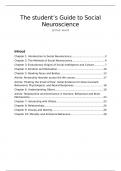The student’s Guide to Social
Neuroscience
Jamie ward
Inhoud
Chapter 1: Introduction to Social Neuroscience...........................................2
Chapter 2: The Methods of Social Neuroscience..........................................4
Chapter 3: Evolutionary Origins of Social Intelligence and Culture..............7
Chapter 4: Emotion and Motivation............................................................10
Chapter 5: Reading Faces and Bodies........................................................13
Article: Personality disorder across the life course.....................................17
Article: Titrating the Smell of Fear: Initial Evidence for Dose-Invariant
Behavioral, Physiological, and Neural Responses......................................18
Chapter 6: Understanding Others..............................................................19
Article: Testosterone and Dominance in Humans: Behavioral and Brain
Mechanisms...............................................................................................23
Chapter 7: Interacting with Others.............................................................23
Chapter 8: Relationships............................................................................24
Chapter 9: Groups and Identity..................................................................26
Chapter 10: Morality and Antisocial Behaviour..........................................28
,Chapter 1: Introduction to Social
Neuroscience
This chapter introduces the field of social neuroscience, examining its
history, core concepts, and key debates. Here's a summary of the main
points:
Defining Social Neuroscience
Social neuroscience seeks to understand how neural mechanisms
influence individuals' thoughts, feelings, and behaviours in social
contexts (real, imagined, or implied presence of others). It bridges social
and cognitive psychology with neuroscience, employing methods and
theories from each.
A Brief History
Although related research existed before, the term 'social
neuroscience' emerged in 1992 in an article by Cacioppo and
Berntson.
The field solidified in the late 1990s and early 2000s, gaining
dedicated journals and societies.
Current research focuses on topics like emotion, self-regulation,
and decision-making, but researchers recognise a need for
greater methodological rigor, ecological validity, and
interdisciplinary integration.
The 'Social Brain': Specialised or General?
A key question in social neuroscience is whether the "social brain" is a
distinct entity with unique mechanisms, or if it utilises general cognitive
processes:
Modularity and Domain Specificity: Some argue for specialized
brain modules dedicated to specific social functions (e.g., face
recognition, theory of mind). These modules are thought to have
evolved to address particular social challenges. Critics compare this
view to phrenology, though modern research employs more rigorous
methods.
Generic Networks: Others propose that general brain networks,
active in various cognitive tasks, also handle social processing. This
view suggests the 'social brain' is defined by the type of information
it processes rather than a unique structure.
, Mirroring as a Potential Social Mechanism: Mirror neurons,
which fire both during action observation and execution, could be a
key mechanism for social cognition. Debate surrounds their precise
function (e.g. imitation, empathy, prediction) and whether they are
truly social or arise from associative learning.
Hybrid Scenarios: It's possible that both specialized and general
mechanisms contribute to social behaviour.
Further research, using diverse techniques like lesion studies and brain
stimulation, is needed to determine the exact nature of the social brain.
Levels of Explanation: Bridging the Gap
Social neuroscience faces the criticism that brain-level explanations are
insufficient for understanding complex social phenomena, which require
social-level analysis. However:
Most social neuroscientists aim to bridge levels of explanation rather
than reduce social psychology to neuroscience. Studies often
combine neuroscience data with social psychology measures like
questionnaires.
Reverse Inference: Researchers attempt to infer cognitive
processes from neuroscientific data. However, this approach requires
caution, as a specific brain region's activation may not always
indicate a particular mental state.
Cultural Neuroscience: Integrating Culture and Biology
Cultural neuroscience provides an example of multi-level explanation by
examining the interplay of culture and neurobiology. It investigates how
cultural systems shape brain function and how biological differences (e.g.
genetic variations) influence cultural practices. While still debated, this
field offers promising insights into cultural differences in social cognition.
Key Takeaways and Future Directions
Chapter 1 sets the stage for a deeper exploration of social neuroscience. It
highlights the field's evolution, core concepts, and central debates. The
chapter emphasizes the importance of:
Carefully considering the nature of the 'social brain' and the
potential roles of specialized modules, generic networks, and
mirroring mechanisms.
Integrating different levels of explanation to understand social
behaviour, acknowledging both neural and social factors.
, Exploring the interaction of culture and biology through cultural
neuroscience.
Future chapters will build on these foundations, providing a detailed
examination of specific social processes and the methodologies used to
study them.
Chapter 2: The Methods of Social
Neuroscience
This chapter provides an overview of the various methods employed in
social neuroscience, acknowledging their strengths and limitations. As a
young field, social neuroscience borrows its methods from related
disciplines, such as psychology and cognitive neuroscience.
Psychological Methods
Social neuroscience studies often incorporate traditional psychological
methods to measure behaviour and cognition:
Performance-based measures: These assess response times and
error rates on experimental tasks, providing insights into cognitive
processes like attention, memory, and decision-making.
Observational studies: Researchers observe and code behaviours
of interest, often quantifying their frequency or duration. This
approach is useful for studying social interactions and non-verbal
communication.
Questionnaires: These self-report measures assess attitudes,
beliefs, personality traits, and emotional states, offering a subjective
perspective on social phenomena.
Limitations: While valuable, psychological methods alone cannot reveal
the underlying neural mechanisms of social behaviour.
Integrating Psychological Methods with Neuroscience
Social neuroscience seeks to connect psychological constructs with neural
processes. This is achieved through methods like correlating questionnaire
data with neuroimaging findings or using performance-based measures in
conjunction with physiological recordings.
Challenge: The vast amount of data generated by neuroimaging
methods, particularly fMRI, can lead to spurious correlations, a
phenomenon termed "voodoo correlations". This issue necessitates careful
statistical analysis and interpretation of results.





